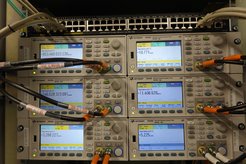Time Reference Distribution System

Radio Astronomy needs accurate timing in order to synchronize with other telescopes for VLBI measurements and to enable high precision pulsar measurements in single dish and interferometric observations.
In Effelsberg, we provide time stamps synchronized with the GPS system to synchronize the observations with global UPS time. For this purpose, we have redundant GNS receivers delivering the time stamps via IRIG-B protocol (analogue modulated signal) through independent antennas and receiver hardware. The differences in-between these two signals are monitored and recorded into a database.
High precision second time pulses (one pulse per second: 1PPS) as well as standard reference frequencies (5 MHz, 10 MHz and 100 MHz) are provided for delivering high precision time stamps on the measured data (1 PPS) and synchronizing all down conversions in the analogue signal chain as well as sampling clocks in the digital backend systems (reference frequencies). All these signals are monitored and recorded into a database over long time range. Our database covers more than 20 years continually.
Hydrogen Maser Clock Technology
All our high precision timing signals are derived from a MASER (Microwave Amplification by Stimulated Emission of Radiation) based on the Hydrogen H1 line. [Read more ...]
